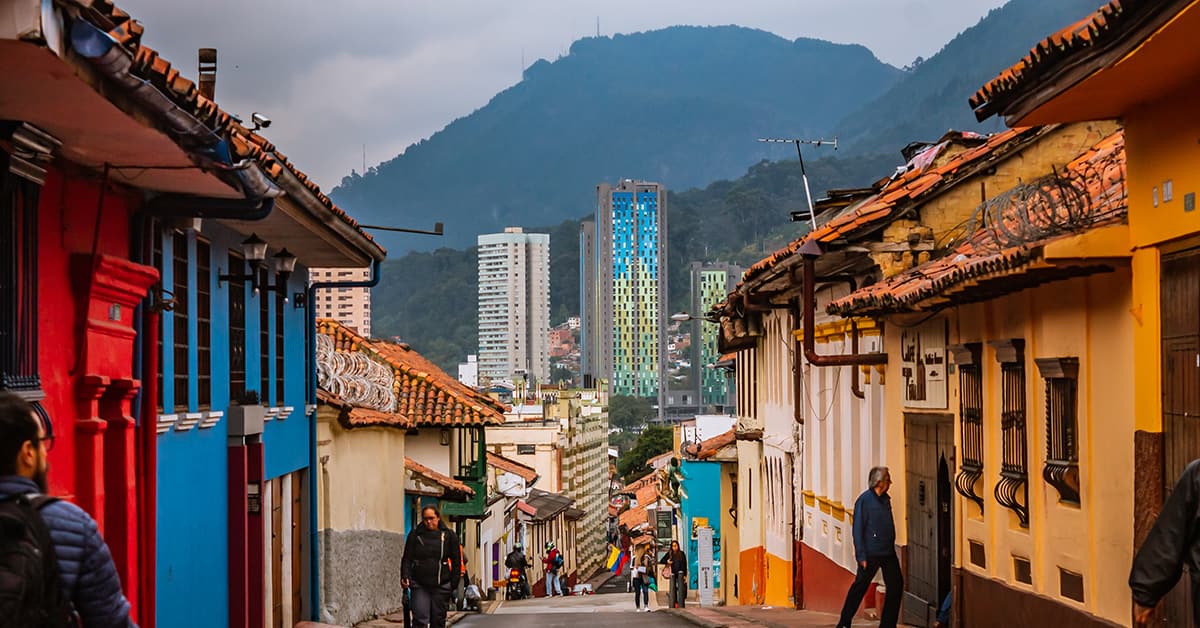Colombia’s economic rebound enters a transitional phase.

|
CONS |
|---|
|
Some social unrest over proposed reforms |
|
Restrictions on foreign ownership still exist |
|
Armed robbery rate back to 2006 levels |
|
Corruption remains a major issue |
|
Moratorium on new extractive concessions |
|
Focus on reforms could lead to short-term legal uncertainties |
|
Inconsistent application and interpretation of existing laws and regulations |
|
Ratings agencies downgraded Colombia to below investment grade in 2021, citing fiscal deficit. Laws have been passed to address this. |
Colombia’s strong economic turnaround coming out of the Covid-19 pandemic was fueled by a dual focus on energy sustainability and tourism, producing a 10.6% jump in GDP growth in 2021—the highest recorded growth since the government’s statistical authority started keeping records in 1975.
President Gustavo Petro’s ambitious proposals to reform health, pensions, work, and taxation laws are aimed at reducing historical inequality. To achieve their goal, however, will require mobilizing a workforce some 60% of whom are under age 35. Reducing Colombia’s dependency on oil will provide investor opportunities if existing sectors can be expanded or new ones created. Agroindustry and the renascence of Colombia’s manufacturing capabilities are two prime options to increase employment.
“The economic environment in Colombia is currently good, but the future depends on the decisions of Petro’s government, especially regarding private investment.” says Daniel Suchar, a Latin American independent analyst.
One of the first tests of Colombia’s status as an investment target concerns oil contracts. A key component of Petro’s campaign promises was to halt the sale of new concessions. The fate of current contracts is expected to be decided later this year.
“The current contracts that are signed and underway will be sufficient for the next 15 years,” says Daniel Velandia Ocampo, head of research and chief economist at Credicorp Capital. “In that period, the world will not demand as much fossil fuels and demand for oil will reduce, so Colombia must prepare for that moment without risking the country’s self-sufficiency.”
That means $20 billion in 2022 exports would need to be replaced with alternatives.
In December 2020, Colombia pledged to reduce its greenhouse gas emissions by 51% by 2030 and work toward achieving carbon neutrality by 2050. Measures include establishing a local green bond market to finance environmental, climate and sustainability initiatives.
In September and October 2021, Colombia issued 10-year sovereign green bonds for a total of COP1.5 trillion ($327.1 million), the first such issued by auction in local currency in the world.
Whatever the result of discussions on current extractive contracts, experts stress that the energy transition must be gradual and careful. “The next few months are going to be important, because in Colombia, oil, gas and coal represent half of exports and are a very important source of tax revenue. In some years they can represent 20% of total government revenue,” says Velandia.
The Battle Over Reforms
Labor reform proposals presented in mid-March center on minimizing outsourcing, defining job tenure and increasing wages for nighttime and holiday work. The country’s business leaders, however, argue that these changes could increase labor costs by 15%. Congressional review of the Petro government’s proposal is ongoing, with results expected in May-June.
Throughout the reform discussion, Colombia’s state institutions, already regarded as strong, have stood firm. The government has repeatedly stated there will be no constitutional changes, and Finance Minister José Antonio Ocampo has emphasized that all reform proposals will conform to fiscal law.
Colombia’s fiscal rule establishes a debt limit of 71% of GDP and a debt anchor of 55% of GDP. The Structural Net Primary Net Balance (BPNE) means the higher the country’s debt, the less money available for primary spending. The “Social Investment Law” 2155 of 2021 created an Autonomous Fiscal Rule Committee, an independent technical body that monitors the fiscal rule that was suspended for two years during the Covid-19 pandemic. Law 2155 is a roadmap to return to those financial spending limits.
“The president is convinced that everything related to social security, health and pensions must have a very strong state apparatus in the middle,” says Velandia. “This will reduce the role of private health-care operators and private pension funds.”
Agriculture’s Key Role
Agriculture and agrochemicals are expected to be another major focus of Petro’s government. The victory of his Humane Colombia party was fueled by support from rural areas and the capital, Bogotá. Colombia has 20 million arable hectares, yet only uses seven million, and ongoing discussions with the 25 guerilla and paramilitary groups that remain from the longtime Colombian civil conflict are aimed at returning this land to productive use. The government proposes to achieve this, and bring about peace, by offering formal land transfers to rural workers.
Logistically, Colombia benefits from having 12 large cities: only Mexico and Brazil benefit from similar networks of decentralized, high-consumption-capacity cities in Latin America. This allows companies to establish themselves away from Bogotá, bolstered by investment in mass transit.
Foreign direct investment in Colombia increased 26.1% year-on-year in 2021, reaching $9.85 billion in 2022, equivalent to 2.58% of GDP. Over 200 foreign companies have entered the Colombian market in the past five years.
In 2022, those with an established footprint announced investments of more than $300 million, including General Motors with a $50 million package to modernize its light-vehicle plant, which has assembled over 1.5 million vehicles in Colombia since 1956. Late last year, PepsiCo announced a $126 million modernization plan. The company employs over 4,000 people in Colombia, producing annual revenue of over $2.3 billion.
China continues to bet on the country through its Small and Medium Business Corporation. The CVCC, which has yet to receive presidential approval, would include a tax-free trade zone with 25,000 warehouses, a seaport and an airport on the Caribbean coast at Sol de Oriente; four of the proposed ports would be situated around Urabá, providing access to both the Caribbean and the Pacific.
Cargill, Kimberly-Clark, L’Oréal and Nestlé have also announced significant expansion plans.
Some four million visitors arrive every year to Colombia and, according to analyst firm Future Market Insights (FMI), the agritourism industry is set to grow from $3.7 billion in 2022 to $7.1 billion in 2032. Tourism contributes 2% of Colombia’s GDP and is the second overall export behind oil, generating 52% of foreign exchange.
Challenges remain, including inflation and a still-volatile political landscape. The International Monetary Fund concluded its Article IV consultation with Colombia at the end of March, noting that the economy was going through a “necessary transition” toward a more sustainable growth path. Despite headline inflation growing to 13.3% year-on-year in February, Colombia remains on course to reach its inflationary targets by the end of 2024.
“While downside risks persist and remain elevated, Colombia’s very strong economic fundamentals, policies and policy frameworks support its resilience,” the IMF report said, adding that access to a $9.8 billion flexible credit line gives Colombia enhanced resilience in most risk scenarios.
Colombia remains an attractive proposition for investors, with incentives that include low, 9% tax rates for new hotels, eco-hotels and theme parks, combined with a resilient economt, growing middle class and established urban markets.



